Sown of Salt and Wind
This article first appeared in the February 2022 issue of Adventure Cyclist magazine.
By the time my dad dropped Dan and me off in front of the blue house on Cherry Street in Woodward, Oklahoma, for the start of our four-day bike tour, the temperature had already tipped past the 100°F mark. I crossed my fingers that my self-made route wouldn’t be as desolate and brutal as the weather. While we attached bags to our gravel bikes — double-checked straps, zippers, the shadowy crevices of the truck — a tenant of the blue house walked outside for her mail and casually asked what we were doing. My dad, without hesitation, shared my life story — I grew up in the blue house until I was eight, went to school down the street, and now Dan and I were doing a bike tour through my childhood memories and family history. She slowly nodded and backed away across the grass as he went on undeterred into the specifics of the bike route: Woodward to Freedom, then on to Alva, Day Three to the Salt Plains State Park, and then finally to Enid, where I graduated high school and where my parents still live. Against his visible excitement for our adventure, she responded, “Wow, that’s … something.”
Looking across the street to where Nanna and Pa had lived, I wondered aloud if the indoor hot tub was still there, and the isinglass birdbath display, but I didn’t creep around the house to look. Driving into Woodward, I’d correctly identified their shop building, Dressen TV, and my old preschool. I knew where the library was located though I hadn’t visited Woodward in decades. The host at Wagg’s Bar-B-Que where we ate before our noon departure did a double take. “Jessica, well I’ll be! I remember you from when you were just a little girl.” She seemed just as struck as me. The inexplicability of memory. The strange anachronism of small towns. Wagg’s was still delicious; I recommend the beef ’n beans and fried okra.
As we pedaled past humble houses to the edge of town and across the two-lane highway onto a country road, I understood that this feeling of familiarity of place, even in my discomfort with it, is the reason the word home exists. Both sides of my family have lived in Oklahoma for generations, begetting and begetting, engaging in the painful and historic creation of the 46th state. How some of them found themselves in this dry and gusty place is a mystery, but my great-great-grandfather George Stong participated in the Cherokee Strip Land Run of 1893 and homesteaded in the eerily beautiful Cheyenne Valley, just equidistant between my two hometowns in northwest Oklahoma. On this trip, I wanted to show Dan the lands and people I came from, not as an homage to George Stong but as a recognition of who I am in the context of a land last-sought, thoroughly stolen, and plowed to dust. I wanted him to see its wonders, too, which are vibrant and remarkable if one takes the time to go slow and look.
On our drive to Woodward, my dad, also a Stong, made a pit stop at the original homestead land. It sits in the shadow of my favorite landmark, Gloss Mountains State Park, which isn’t mountains but red-and-white-striped plateaus, the remnants of an ancient inland sea. We visited George’s grave in the Cheyenne Valley Cemetery. A bull snake watched, flicking its tongue at us.
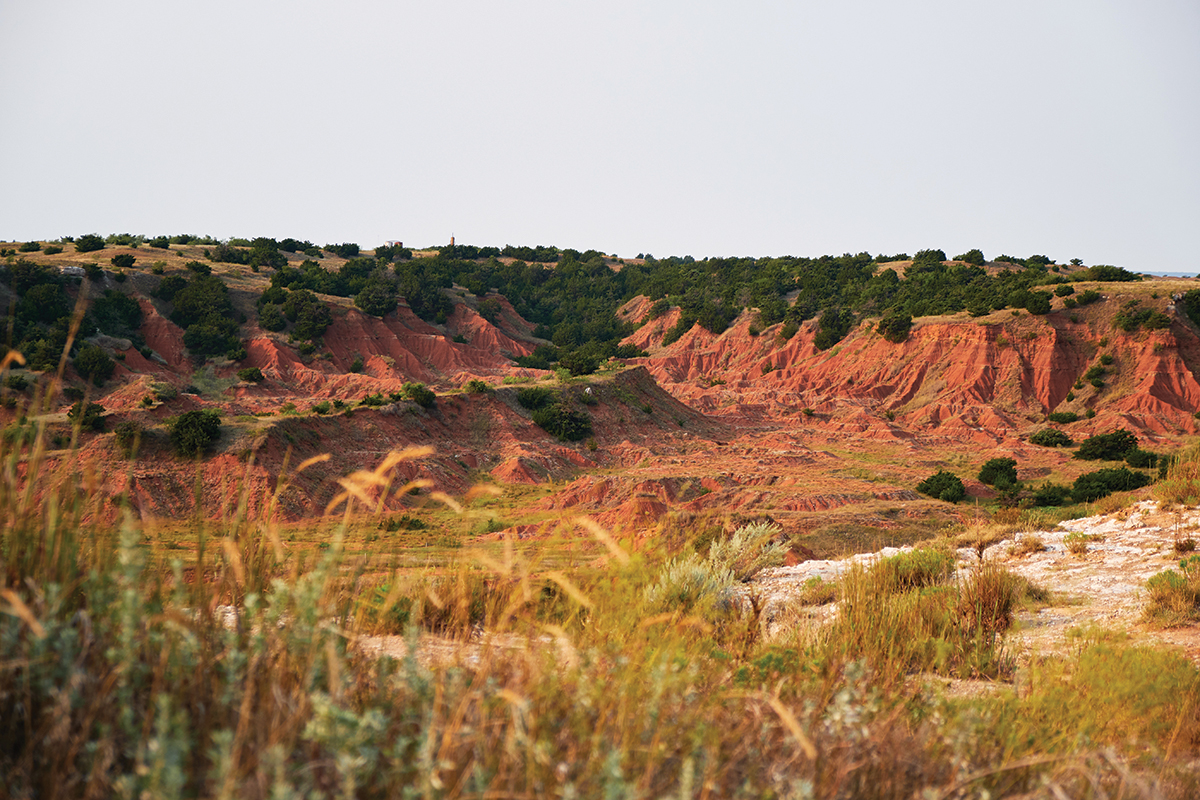
As a first-time visitor to the state, Dan was without expectation or context, so we went to the Cherokee Strip Regional Heritage Center in Enid before the bike trip. Essentially, he learned that white people wanted land, and that as part of the Homestead Act, the U.S. government paid the Cherokee Tribe for an approximately eight-million-acre rectangular swath of their land in northwest Indian Territory and opened it to settlers. The government’s process for distributing land was an ill-planned race complete with little flags on stakes that a “boomer” (racer) would use to claim a 160-acre homestead site.
An estimated 100,000 people lined up on a handful of starting lines at the edges of the Cherokee Outlet on September 16, 1893. It was hot, 110°F by some reports, and desperately dusty from a long drought. At noon, the guns fired and the race was on. With the people far outnumbering the available homesteads — and with most boomers favoring the lusher eastern edge of the Outlet — many turned back to Kansas empty-handed. Some stayed on to fight as many as 10 others for the same claim. Competing claims overwhelmed land offices in the new towns of Woodward, Enid, Perry, and Alva.
“To compete in a race with a little flag seems like a ridiculous and inefficient way to dole out land,” said Dan. “Like it’s from a movie, not reality.”
What Dan didn’t learn at the Center was how the area was used and inhabited for centuries before George Stong made his historic run that landed my family in a south-central plot of land on the Cherokee Outlet. The expanse of land now called Oklahoma was home to others, beginning with the Spiro Mound Builders as far back as A.D. 500. The Caddo, Wichita, Pawnee, Quapaw, Osage, and Athapascans settled along rivers in the verdant eastern region; the Osages are known to have trod the first consistent trade and hunting paths through the northwest, following the Cimarron River; the Kiowa, Comanche, Arapaho, Apache, and Cheyenne moved in and out as forces within them and without pushed and pulled. While some Tribes lived occasionally in the area of their own accord, all of the 39 Indigenous Nations that currently reside in Oklahoma were pressured there in a process known as “removal.” Post-removal, treaty after treaty siphoned Indian Territory away from Indigenous control.
In 1866 and 1890, the sum parts of the Cherokee Outlet were coerced from the Cherokee, first for the removal of Tribes from Kansas and then for the opening of white settlement. Allotment quickly followed for the Tribe — a process of forcing individual land ownership on a communal culture. Since private land can be swindled and sold, by the 1920s about 90 percent of Cherokee lands had passed to white control, according to Indian Tribes of Oklahoma by Blue Clark. As with the Cherokee, so went the other Tribes, and that, in short, is how Oklahoma came into statehood. Over the last century, Tribes have fought for and gained sovereignty, rebuilding their communities and culture on this mercurial landscape.
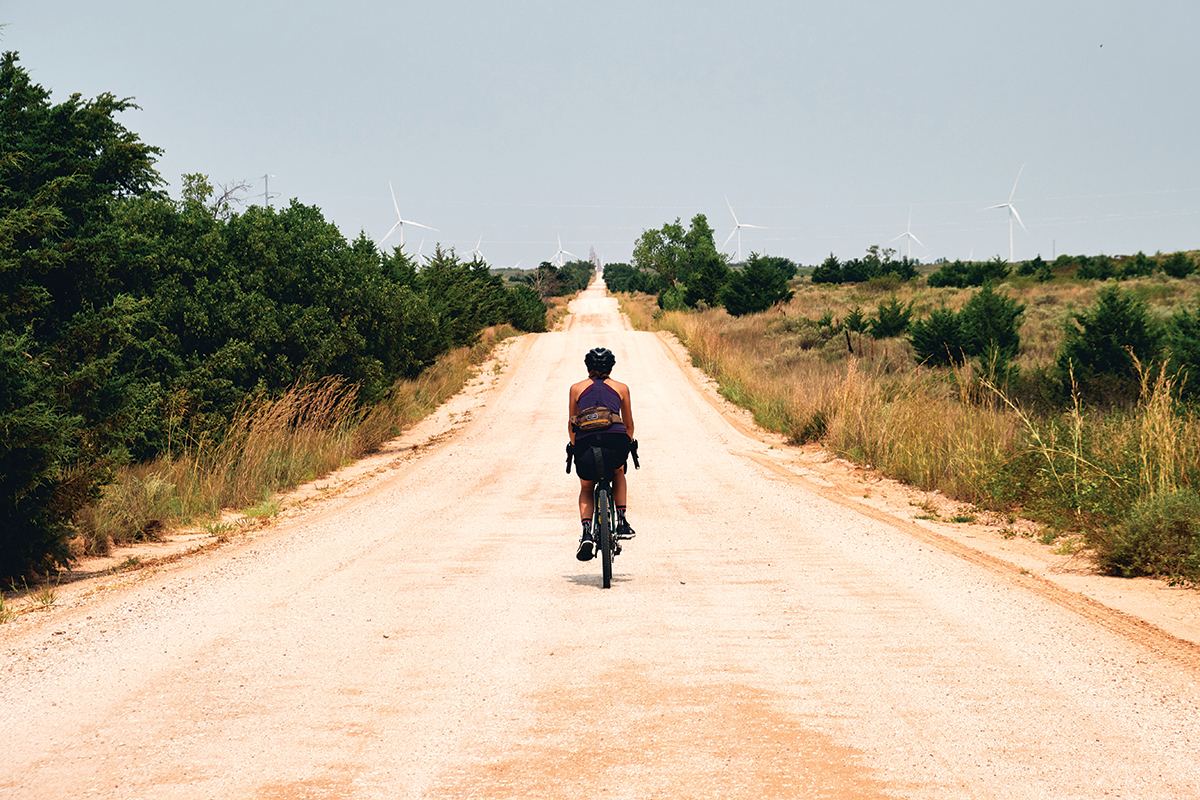
After riding through Boiling Springs State Park — the last green, treed, and rolling landscape for miles — we headed north. Blinded by the crushed white gypsum on the dirt road, we could only look ahead to the horizon stretched wide before us. A dry 25 MPH wind pushed against our backs. With the winter wheat harvested months prior, the empty fields sat bare, their red clay soil turned up to the sky. The ditch grass and wild sunflowers stood tall in contrast and waved to us with the wind. We ate ripe wild sand plums, then rode past a new industrial wind farm, the massive blades slowly whirling, bright as the gypsum in the sun.
In the late afternoon, we arrived hot and thirsty at Alabaster Caverns State Park, one of the largest gypsum caves in the world. We bought tickets for a tour and downed sodas and ice cream from the visitor center. Underground, we relaxed in the cool, damp darkness. Nicole, our young guide, was a local, born and raised in Freedom, seven miles north and our destination for the evening, population 289.
“I work part time at the caves, and the rest of the time I work on the family farm,” Nicole said. “We grow wheat and cattle. There’s not really anything else to do around here. Just wheat and cattle.” She then cracked jokes about how Kansans have to come to Oklahoma for their entertainment.
She meets people from all over the world who tour the caves, but she hadn’t met anyone traveling there by bicycle and she was curious. I liked the sound of possibility in her questions. Her voice had the familiar lilt of a southern accent gone rough, and I wondered if she was like me, of a family with roots sunk so deep in their own claims that they turn to alabaster.
George Stong was so drawn by the promise of land that he towed his young family, aging parents, and two other families to Caldwell, Kansas, to register for the Run. He’d fallen in love with the Cheyenne Valley despite its rock and clay soil and its brackish water unfit for drinking. The families filled their six covered wagons with timber and equipment and beelined it for the carved-out ancient lake bed. He raised horses and cattle, planted hay and wheat, and built a two-story house. Of his 11 children, six lived. His wife, Sarah, who would hit him with pillows when he tried to kiss her, abandoned the farm and her children for another man named George. Undeterred by tragedy and early blindness, George Stong plowed on.
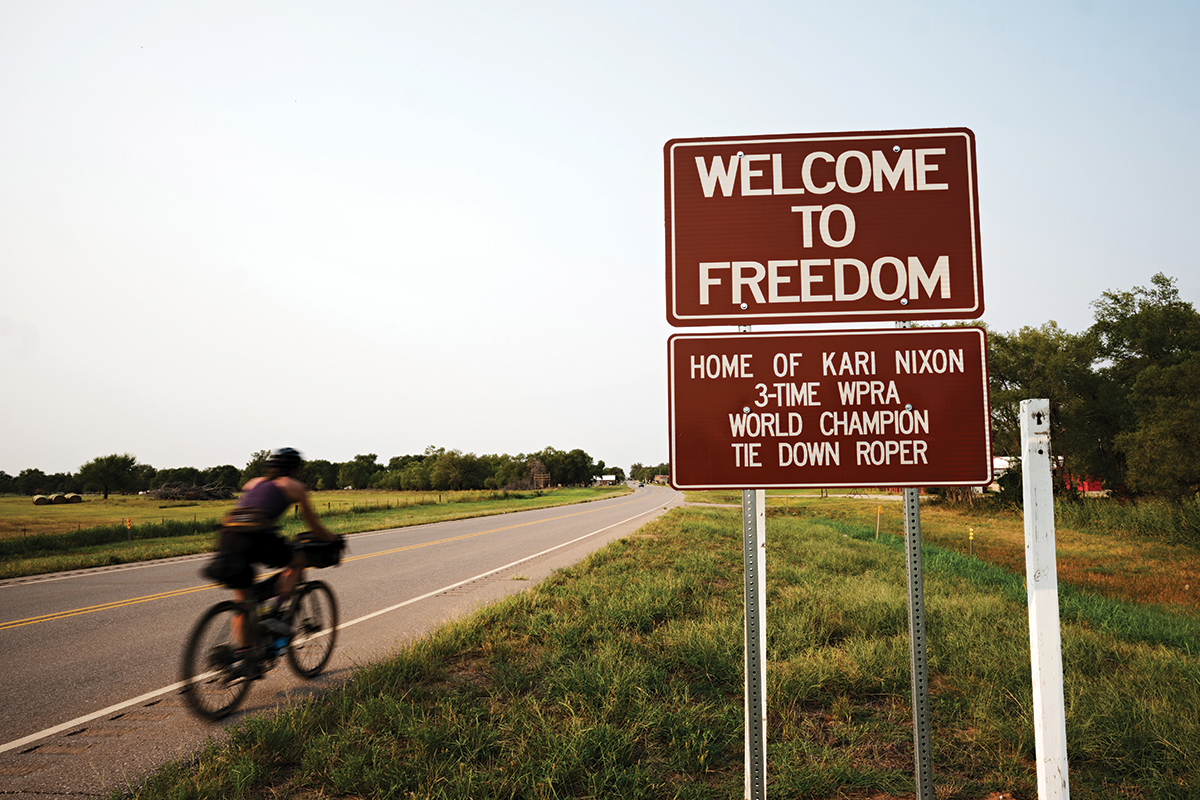
Rolling into Freedom, Dan appeared surprised by its meagerness. We bought gas station dinner (frozen pot pies, canned peaches) and checked in at the Freedom Cabins, two red single-wide trailers. Besides the gas station, the only operational establishment was the bar. Dan took photos of the rodeo memorabilia covering the bar’s walls. One of the patrons began to spin yarns of his farm’s archeological dig: dinosaur bones, mammoth skeletons, human evidence so old it changed archeology. When he planted, he said, his plow would strike a new artifact regularly, scuffing it up. He’d toss them aside until he noticed some of them were bones. Big bones. And then the archeologists took over his farm. The other two beer drinkers chimed in, familiar with the story, pushing photos under our noses.
Sure, sure, I thought, mentally waving them off. My grandmother had an archeological dig on her farm too. I still have a foot-long fragment of a mammoth tusk. Same old story. (Only later did I realize I’d been talking to a farmer who made radical history, whose find significantly altered the date of the earliest humans on the continent — the Burnham Site.)
The farmer pulled a sharpened rock out of his pocket.
“I found that just today. It’s a knife. I find stuff like that every day. We’re reconstructing a brontosaurus leg bone right now,” he said.
The patrons eventually felt comfortable enough with us to relax, count us in. They talked with growing antipathy of the smoke from California fires that tinged the Oklahoma skies. How the “tree huggers” didn’t know how to take care of the land. That they, Oklahoma farmers, were “stewards of the land.” Their methods were the right ones. I didn’t bring up the Dust Bowl or inquire as to the current state of their aquifer. I didn’t ask how many years their families had lived here but, for mine, it’s not all that long, not in comparison to the communities here first.
When our new acquaintances began to speak of the “Communist Chinese” family that they were working on ousting from Freedom, we took our leave and walked back to our single-wide.
“I’m always so excited to come back to Oklahoma,” I said. “I don’t know why because I always know it’ll disappoint me.”
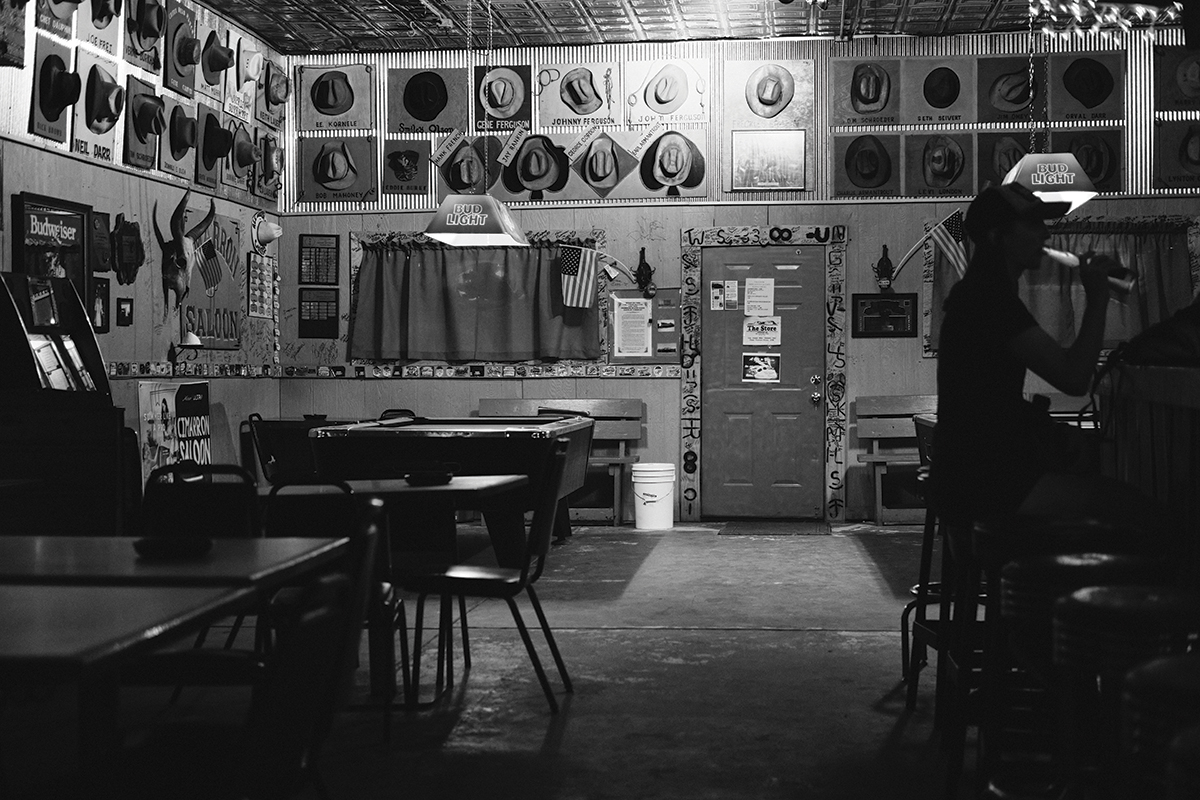
The next morning, we ate our gas station Cheerios and rode the four blocks out of town. Thousands of butterflies dancing over the cover crop of clover flashed lovely in the golden light. Scissortail flycatchers darted for their own breakfasts. The wind was yet a breeze.
“See,” we said to each other. “Can’t it be lovely?”
As with Woodward, my memory served me well and the odd hilliness came as expected. Dan shouted, “Woohoo! Downhill!” and sped past me. The hard-packed roads were a gravel rider’s dream. I pointed out a large hare running alongside the barbed wire, easily outpacing us for 200 meters until it dove into the brush. At a turn in the road, a big, healthy herd of horses took off at a thunderous gallop beside us. I couldn’t help but laugh.
Forty-some miles wasn’t far on smooth dirt roads, but it felt longer in the unceasing sun. Turning south to enter Alva, we met a fierce headwind and hunger; it was past time for lunch. We inched by the big park and swimming pool my Grandma Bettye took me to as a kid and made our way to Church Street where she had lived. My eyes felt tired and my legs were zapped but despite the years, something in me knew her house was up the hill. I told Dan to wait at the bottom as I rode up to check. It appeared, an unremarkable single-story brick house, and I simply stopped in the middle of the street and stared, letting the memories come.
Grandma Bettye wasn’t a Stong, wasn’t even from that side of the family. She claimed she was Choctaw though she wasn’t a Tribal citizen, and with colonialism’s centuries of calculated Indigenous fracturing and erasure, I’ll likely never know with certainty. But she had olive skin and straight black hair that she had permed since childhood so that she would look more like Shirley Temple and less like herself. She was tall and prone to laughing, stretching the truth, saying, “Mercy” under her breath. And in the back of that house, she grew asparagus and sunflowers. Dan saw I wasn’t moving and pedaled up the hill to rub my shoulder while I remembered. After a bit, I composed myself and all the memories tumbled out. We talked about our favorite grandmas the rest of the day, and I considered how impossible it is, under the weight of history, to know whether I am of this or that or simply of the stories I tell myself.
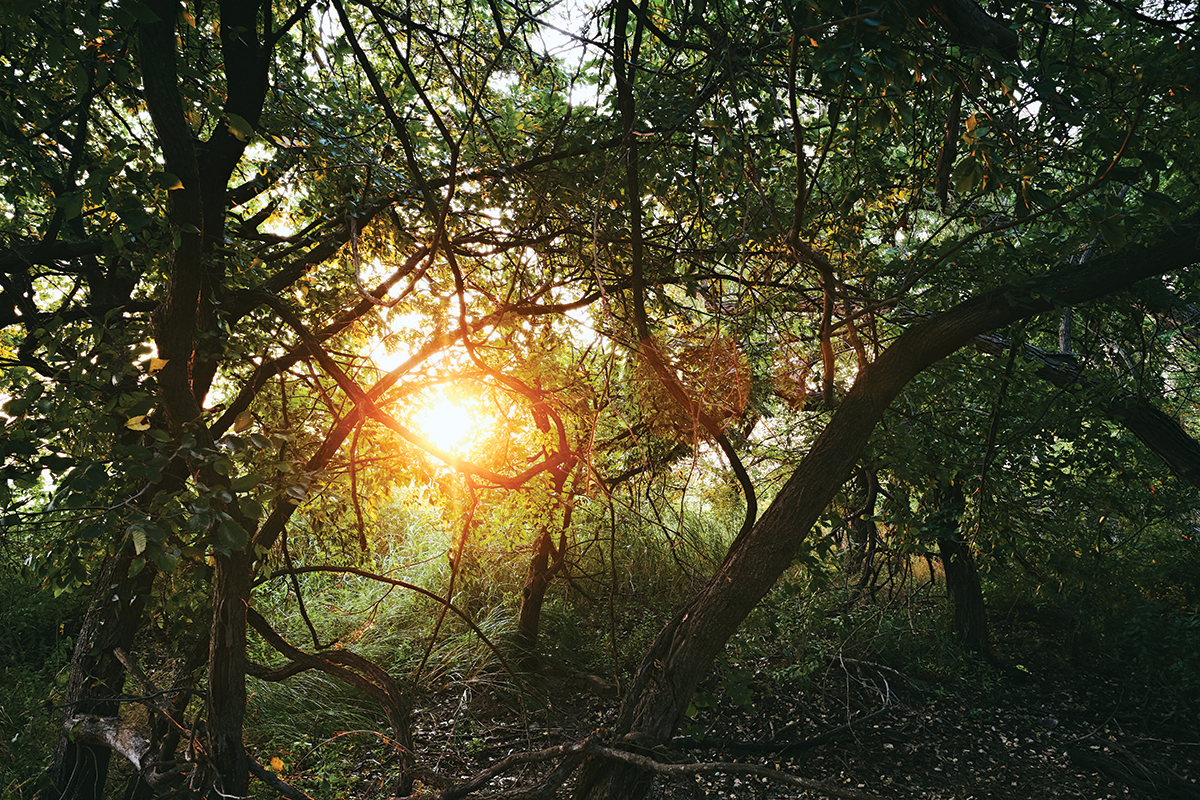
In Alva, we checked into our motel room early, stuffed our faces with bad food, and rested through the late-afternoon heat. Later we rode downtown, whose square, like all county seats, was planned and plotted as a townsite for the Land Run. Designers even ruled on how wide the streets would be and exactly how the courthouse would sit in the middle. Dan snapped photos of the derelict grain elevators, the empty square, the boarded-up buildings.
Like Woodward and nearly every town in the Cherokee Outlet, Alva’s population has been shrinking since statehood in 1907. Woods County has dwindled by half in the last century. The quaint bowling alley diner where Grandma and I ate breakfast, the regal old buildings of Northwestern Oklahoma State University, the art deco extravagance of the Rialto Theater all reflect the hope and decline of the Outlet.
What Oklahoma does have in abundance is Sonic, a fine Oklahoma-born drive-in eatery. Full of Sonic breakfast, we tackled Day Three: the longest and most full of potential. Dan knew we were headed to Salt Plains State Park but didn’t understand what it meant until we pedaled out onto the vast, white salt flat. It was such a sudden and unexpected thing on the plains that it felt ridiculous to exist at all. I enjoyed watching him walk around in baffled wonder. He asked why there were people and cars on the flat. They were digging for selenite gypsum crystals — the only place on the planet these hourglass crystals are found — and I wanted so badly to dig with Dan but we lacked shovels, buckets, and towels, and the salt reflected the sun in visible heat waves.
“Next time,” I said, not knowing if or when the next time might come.
Dan popped a few wheelies and we took our leave, riding for the rest of the day around Salt Plains Lake to the state park where my parents met us with beer, snacks, and an air-conditioned RV. Large deciduous trees shaded our campsite, which had a view of the lake. We prodded and wondered over an alien-like insect called a cottonwood borer. There is nothing so good as to sit in the shade with a beer and listen to the thrum of the natural world after a long day of cycling.
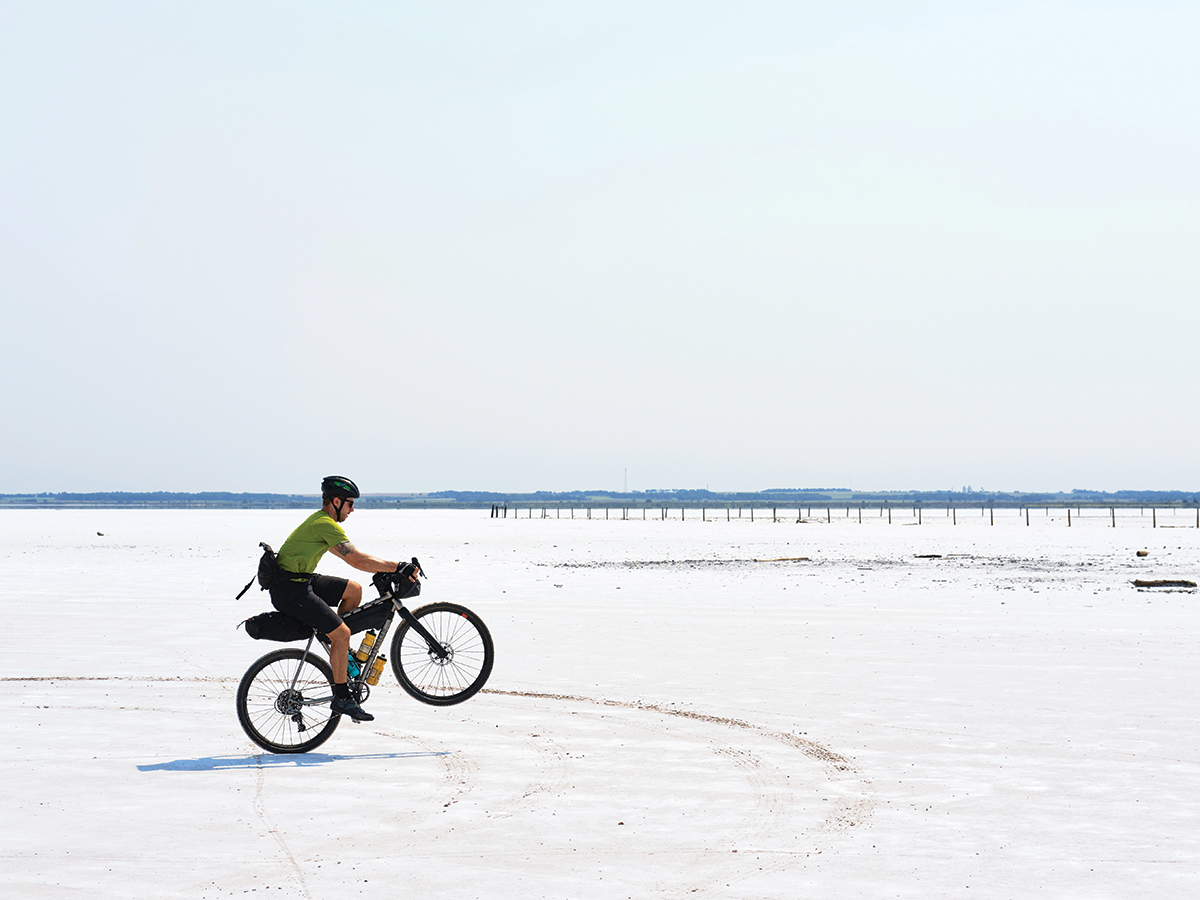
After a dinner of my parents’ finest beans and cornbread, Dan and I headed for the National Wildlife Refuge, a swampy and wooded walking path along the lake’s inlet. At the edge of the lake, we stood in the blind and watched the innumerable bird species wade in the shallows. The setting sunlight glinted off of the water and backlit the throngs of pelicans, sandpipers, herons, egrets, cranes, avocets, plovers, and more. Forty of the 47 shorebird species of North America have been found at Salt Plains Lake, and Dan is the sort of birder who can identify a bird simply by its song. He stooped next to me, staring through the cut in the blind, his eyes aglow in the sunset. I listened to the drowning hum of cicadas rise and fall together, felt the breathing life of the place on my skin, and just missed stepping on a gray snake as it streaked away. Every now and then, Dan would make quiet exclamations of joy or wonder, the abundance of nature a surprise he didn’t expect on the grassy plains.
“I love it here,” he said. “It’s beautiful. Everything is so alive.”
And that was it — the moment I’d tacitly hoped for — where the person I loved in all of his complexity saw a piece of Oklahoma he could love in all of its complexity, a place that made him come alive and feel hopeful. I wondered if George Stong felt the same looking upon the red dirt and tall grasses of the Cheyenne Valley, whether he felt more alive there, mustered up more hopes there, than anywhere else he’d ever been.
Still, Oklahoma never lets me forget that she is a hard place. The next day, we rode a painful 38 miles south into a bracing headwind. When we drifted into my parents’ driveway in Enid, we were glad to be done. We tottered our bikes to the garage, downed ice water, and soaked in the AC. My parents glowed and congratulated us, asking again for details though there was nothing more to say other than it was a very good trip.
The entire ride, I’d worried that Dan wouldn’t experience Oklahoma in the way I knew it — that he would only see an empty landscape, flyover country. But I should have trusted us more. I should have trusted the process of the pedal stroke to open up the secrets of the land and give us the time to see and talk and listen. I should have known that if the golden dreams of a man hard up in 1893 were enough to bring forth generations of descendants across northwestern Oklahoma, my memories of home — of the small beauties and bitter realities — would be enough to lead Dan through the wind and back to the places that make us both feel most alive.

